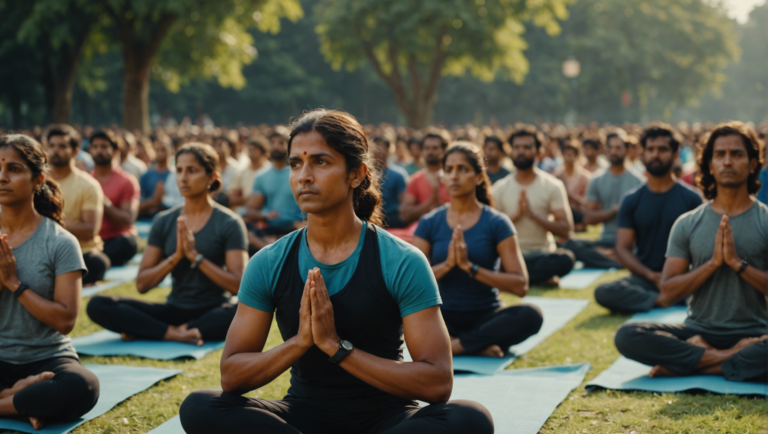Enhancing Your Fitness: The Benefits Of Yoga Strength Training
Unveiling the Power of Yoga Strength Training
The integration of yoga with strength training is not just a trend but a comprehensive approach towards achieving holistic fitness. While yoga has been celebrated for its ability to increase flexibility, reduce stress, and improve mental health, its benefits in the realm of strength training are often overlooked. This blend offers a unique combination that can enhance physical stamina, muscle tone, and mental resilience, making it a valuable practice for individuals looking to elevate their overall fitness.
Combining Flexibility with Strength
The synergy between yoga and strength training lies in their complementary nature. Strength training exercises, such as weight lifting, enhance muscle mass and bone density. However, without adequate flexibility and mobility, the range of motion can be limited, leading to a higher risk of injuries. Yoga, known for its stretching postures, can significantly improve flexibility and mobility, thereby supporting the body’s ability to perform strength training exercises more effectively and safely.
Enhancing Muscular Balance and Posture
Yoga strength training goes beyond the superficial layers of fitness by targeting the deep, stabilizing muscles that are often neglected in traditional weight training routines. Poses that require holding the body’s weight, such as plank variations or warrior poses, engage multiple muscle groups simultaneously. This not only builds muscular strength in a balanced manner but also improves posture and alignment, which are crucial for optimal performance and injury prevention in any physical activity.
Boosting Mental Resilience and Focus
One of the standout benefits of integrating yoga into strength training is the impact on mental health and cognitive function. Yoga practices, particularly those that emphasize mindfulness and breath control, can significantly enhance focus, mental clarity, and resilience. These mental benefits are pivotal when engaging in strength training, where concentration and mental stamina play a vital role in executing exercises with proper form and intensity.
Accelerating Recovery and Reducing Injury Risk
Recovery is an integral part of any fitness regimen, yet it is often underestimated. The restorative aspects of yoga, including gentle stretching and relaxation techniques, facilitate faster recovery by improving blood circulation and reducing muscle stiffness. This not only accelerates the healing process post-strength training but also diminishes the risk of injuries by ensuring that muscles are not overstrained and that the body maintains its flexibility and mobility.
Creating a Sustainable Fitness Practice
The union of yoga and strength training embodies a sustainable approach to fitness. Unlike high-intensity workouts that can be challenging to maintain in the long run, especially with aging or during periods of stress, yoga strength training offers a balanced regimen that can be adapted to suit different life stages and physical conditions. This adaptability not only promotes long-term health and fitness but also encourages a consistent and enjoyable fitness journey.
Maximizing the Benefits of Yoga Strength Training
To fully harness the benefits of yoga strength training, it is essential to:
-
Start with a Solid Foundation: Before diving into more advanced practices, develop a strong foundation in basic yoga poses and strength training principles. This ensures safety and maximizes the effectiveness of your regimen.
-
Listen to Your Body: A key principle of yoga is mindfulness and tuning into your body’s needs. Apply this approach to strength training by being mindful of your body’s signals, avoiding overexertion, and allowing adequate time for recovery.
-
Seek Professional Guidance: Whether you’re a beginner or looking to deepen your practice, guidance from certified instructors can provide personalized insights and adjustments, enhancing the benefits of your fitness regimen.
This holistic fusion of yoga and strength training redefines what it means to be fit. It highlights the importance of balancing physical strength with flexibility, mental resilience, and overall well-being, making it a formidable approach for anyone aiming to enhance their fitness in a holistic, sustainable manner.
The Science Behind Yoga and Muscle Building
As the global fitness landscape evolves, the fusion of traditional practices like yoga with modern strength training principles has emerged as a potent methodology for building muscle and enhancing overall physical well-being. This interdisciplinary approach leverages the science of muscle hypertrophy, flexibility, and mind-body integration, offering a comprehensive fitness paradigm that transcends conventional boundaries. Delving into the scientific intricacies reveals why this combination is not only effective but revolutionary.
Understanding Muscle Hypertrophy in the Context of Yoga
Muscle hypertrophy—the process of increasing muscle mass—is traditionally associated with weightlifting and resistance training. However, yoga, with its diverse array of asanas (poses), engages muscle groups in a sustained, isometric manner. This type of muscle engagement is conducive to muscle fiber recruitment, particularly Type I (slow-twitch) fibers, which are endurance-oriented but can also contribute to muscle size and strength when challenged under tension for prolonged periods.
The key to muscle building, irrespective of the exercise modality, lies in the concept of ‘progressive overload’. In a conventional gym setting, this is achieved through increasing weight. In contrast, yoga facilitates progressive overload by varying the complexity of poses, adjusting the duration they are held, and incorporating elements like transition speed or added resistance, thus stimulating muscle growth through unconventional yet effective means.
The Role of Flexibility and Mobility
Flexibility and mobility are often touted benefits of yoga, but their importance in muscle building is frequently understated. Enhanced flexibility improves the range of motion, allowing practitioners to perform exercises with greater depth and efficiency, which is crucial for optimal muscle activation and growth. Moreover, yoga’s emphasis on mobility contributes to joint health, reducing the risk of injuries that can sideline progress in strength training.
The interconnectedness of flexibility, mobility, and muscle building is grounded in the science of fascial elasticity and muscular efficiency. Yoga exercises promote the elongation and strengthening of the fascia—the connective tissue surrounding muscles—thereby facilitating a smoother glide of muscle fibers during contraction and relaxation phases of strength training movements. This synergy not only augments the muscle-building capacity but also enhances overall functional fitness.
The Mind-Body Connection: A Catalyst for Growth
One of the most distinctive elements of integrating yoga into a muscle-building regimen is the emphasis on the mind-body connection. This holistic engagement goes beyond the physical to harness the power of mental focus and breath control, key components of yoga that significantly impact training efficacy.
Scientific studies have underscored the role of mental focus in muscle activation. The conscious engagement of target muscle groups, a practice honed through yoga, can amplify the results of strength training by fostering a deeper neuromuscular connection. Furthermore, breath control techniques improve oxygenation and can enhance endurance, allowing for more intensive training sessions with a potentially faster recovery.
Practical Integration for Optimal Results
Transitioning from theory to practice, the integration of yoga into a muscle-building routine can take various forms. It could be structured as a warm-up to prepare the body and mind for strength training, incorporated as active recovery to enhance flexibility and reduce muscle soreness, or even woven into the strength training sessions themselves through hybrid exercises that merge yoga poses with resistance elements.
For individuals looking to adopt this integrated approach, consistency and mindfulness are paramount. Listening to the body and adjusting practices to cater to personal fitness levels and objectives can maximize the benefits of this fusion, ensuring a balanced and sustainable path to muscle development.
Crafting a Routine that Resonates
Designing a workout routine that encapsulates the essence of yoga and strength training is both an art and a science. It requires an understanding of one’s own body, fitness goals, and the principles underlying muscle growth, flexibility, and the mind-body connection. By blending these elements thoughtfully, individuals can create a holistic regimen that not only builds muscle but also enhances overall well-being, illustrating the profound impact of this interdisciplinary approach on modern fitness paradigms.
Optimizing Mental and Physical Health with Yoga Strength Techniques
Yoga strength techniques are an ever-evolving discipline that harnesses the power of body and mind to offer a holistic approach to well-being. This approach interweaves the ancient principles of yoga with contemporary fitness practices to optimize mental and physical health, demonstrating a symbiotic relationship between strength, flexibility, balance, and mental clarity. Bridging the gap between traditional yoga and strength training, yoga strength techniques are designed to sculpt the body, enhance vitality, and promote a deep sense of inner peace.
Unveiling the Science Behind Yoga Strength Techniques
At the core of yoga strength techniques lies the principle of progressive overload—a concept well-understood in traditional strength training. This principle is adeptly applied through poses and sequences that progressively challenge the body’s muscles, fostering strength and endurance without the need for external weights. The unique combination of isometric holds (where the muscle length does not change during contraction) and dynamic movements enhances muscular strength, promotes hypertrophy, and improves metabolic rate, contributing to more efficient fat burning and muscle definition.
The Psychological Advantages of a Strengthened Yoga Practice
The mental health benefits of yoga have been well-documented, ranging from reduced stress and anxiety to improved mood and cognitive function. When strength elements are integrated into yoga practice, these benefits amplify. The focus required to maintain challenging poses not only fortifies the body but also trains the mind, enhancing mental resilience and emotional equilibrium. This mindful approach to strength training fosters a heightened sense of body awareness and cultivates a mental state of flow, where the individual is fully immersed in the activity at hand.
Crafting a Balanced Body and Mind
Yoga strength techniques place a significant emphasis on balance and flexibility, counteracting the muscle tightness that can often accompany traditional strength training. By promoting a harmonious development of all muscle groups, these practices minimize the risk of injury and contribute to a more balanced physique. Furthermore, the incorporation of breath work and meditation into a yoga strength regimen enhances lung capacity, aids in stress management, and supports overall cardiovascular health.
Tailoring Yoga Strength Techniques for Individual Needs
One of the most appealing aspects of yoga strength techniques is their adaptability. Regardless of fitness level or experience, individuals can tailor these practices to meet their unique needs and goals. Beginners may start with basic poses to build foundational strength, while advanced practitioners can explore more complex sequences and holds. This customizable approach ensures that anyone can benefit from yoga strength techniques, making them a versatile and inclusive option for optimizing health.
The Community Aspect of Group Practice
Practicing yoga strength techniques in a group setting adds a communal dimension to the journey toward health and well-being. This community can provide motivation, accountability, and support, enhancing the overall experience. Sharing the challenge of a yoga strength class fosters a sense of connection and camaraderie among participants, contributing to a positive and uplifting environment.
Yoga strength techniques offer a comprehensive approach to fitness, blending physical, mental, and spiritual practices to create a balanced and fulfilling lifestyle. By integrating the principles of strength training with the holistic benefits of yoga, individuals can enjoy enhanced physical health, mental clarity, and emotional well-being. This dynamic and adaptable practice invites practitioners of all levels to explore their potential and embark on a transformative journey toward optimal health.
Tailoring Your Yoga Routine for Maximum Strength Gains
Yoga, traditionally viewed as a practice for enhancing flexibility and mindfulness, has evolved. Many now leverage yoga for its surprisingly potent benefits in building strength, endurance, and muscle tone. This evolution of yoga practice integrates dynamic poses and methodologies aimed at amplifying physical strength, debunking myths that yoga is solely a passive or restorative practice. To harness the full potential of yoga for strength gains, a tailored approach that emphasizes specific poses, sequences, and principles is essential. This article delves into expert strategies to sculpt a yoga routine that maximizes strength gains, embodying a symbiotic blend of ancient wisdom and contemporary fitness principles.
Crafting a Balanced Routine for Strength Enhancement
A well-rounded yoga routine for strength building should include a mix of dynamic Ashtanga or power yoga sequences alongside traditional poses that target core, upper, and lower body strength. Vinyasa flow, recognized for its continuous movement between poses, serves as an excellent foundation for integrating strength training into your yoga practice. Key poses such as Plank, Chaturanga, Warrior series, and Chair pose, when executed with precision and held for extended durations, stimulate muscle growth and endurance akin to conventional strength training exercises.
Prioritizing Core Engagement
The core is the cornerstone of strength in yoga, pivotal for maintaining balance, posture, and power in various poses. Integrating core-centric poses like Navasana (Boat Pose), Paripurna Navasana (Full Boat Pose), and Vasisthasana (Side Plank Pose) can dramatically enhance core stability and strength. These poses not only fortify the abdominal muscles but also contribute to a robust lower back, mitigating the risk of injury and improving performance in physical activities outside the yoga mat.
Integrating Props and Resistance
To further amplify strength gains, incorporating yoga props such as blocks, straps, and resistance bands into your routine can introduce an elevated level of challenge and versatility. Props aid in maintaining alignment, deepening stretches, and adding resistance to certain poses, making them more strenuous and thereby more conducive to strength development. For instance, using a resistance band in poses such as Warrior III can heighten leg and glute strength by creating additional tension.
Emphasizing Slow, Controlled Movements
In the realm of strength gains, the pace at which poses are executed is as crucial as the poses themselves. Implementing a slow, deliberate pace ensures muscles are engaged thoroughly and consistently throughout the practice. Transitioning slowly between poses enhances muscular endurance and control, with an emphasis on isometric holds to maximize muscle engagement. This approach not only augments strength but also cultivates patience and focus.
Dedication to Progressive Overload
Just as with traditional strength training, adhering to the principle of progressive overload is critical in a yoga routine aimed at strength gains. Gradually increasing the intensity of the practice, either by extending the duration of poses, incorporating more advanced variations, or adding more sequences that challenge strength and endurance, ensures continuous improvement and prevents plateaus. Regularly assessing progress and updating the routine to reflect enhanced capabilities is fundamental for sustained growth.
By tailoring your yoga practice with a focus on strength enhancement, you unlock a multifaceted fitness regimen that transcends conventional boundaries. The fusion of mental fortitude and physical vigor that yoga offers is unparalleled, fostering a holistic approach to wellness and strength. these strategies into your routine not only elevates your yoga practice but also contributes significantly to your overall fitness journey, proving that the ancient discipline of yoga remains as relevant and powerful today as ever.
Bridging the Gap: Yoga and Traditional Strength Training Synergies
Uniting Yoga and Traditional Strength Training: A Comprehensive Approach
The fitness landscape is continuously evolving, and amidst this change, the fusion of yoga and traditional strength training emerges as a revolutionary approach. This synergy not only enhances physical fitness but also promotes mental well-being, offering a holistic path to health that transcends the benefits of each practice independently.
Understanding the Synergy
At first glance, yoga and traditional strength training might seem like polar opposites. Yoga, with its roots steeped in ancient philosophy, emphasizes flexibility, balance, and the connection between mind, body, and spirit. On the other hand, strength training, a cornerstone of modern fitness regimens, focuses on enhancing muscle mass, power, and endurance. However, when combined, these seemingly disparate practices offer a balanced approach to fitness that addresses a comprehensive range of physical and mental health goals.
The Physical Benefits of a Combined Approach
The integration of yoga into a strength training regimen can significantly amplify physical benefits. Yoga’s stretching exercises improve flexibility and range of motion, elements that are crucial for performing strength training exercises correctly and safely. This improved flexibility also aids in the recovery process, reducing the risk of injuries. On the flip side, the muscle-building aspects of strength training provide the power and endurance needed to perform advanced yoga poses, thereby creating a cycle of mutual enhancement.
Mental and Emotional Enhancements
The mental and emotional benefits of combining yoga and strength training are profound. Yoga practices, especially those focusing on breath control and meditation, cultivate mindfulness and reduce stress. This mental clarity and reduced anxiety can significantly improve focus and motivation during strength training sessions. Furthermore, the confidence gained from achieving strength milestones can empower individuals in their yoga practice, fostering a positive feedback loop of mental and bodily health.
Structuring a Combined Fitness Regimen
Crafting a fitness regimen that harmonizes yoga and traditional strength training requires a thoughtful approach. It’s beneficial to alternate between yoga and strength training sessions, allowing the body time to recover and adapt to the varied demands of each practice. Additionally, focusing on yoga practices that complement the muscles used in strength training can enhance overall performance and reduce the likelihood of overuse injuries. Tailoring the intensity and frequency of each practice to individual fitness levels and goals is crucial for maximizing the benefits of this combined approach.
Testimonials and Scientific Backing
Anecdotal evidence and scientific research alike support the benefits of this integrated approach to fitness. Individuals who have embraced the fusion of yoga and strength training often report improvements in overall strength, flexibility, and mental well-being. Emerging studies suggest that such a combined approach can lead to better balance, posture, and functional fitness than either practice alone, validating the experiences of many who have ventured into this hybrid form of physical conditioning.
A Path Forward for Fitness Enthusiasts
For those looking to enrich their fitness journey, merging yoga with traditional strength training offers a path that balances intensity with introspection, power with flexibility. This synergistic approach not only elevates physical capabilities but also nurtures mental resilience, illustrating that true fitness transcends physical strength, encompassing mental and emotional well-being. As the fitness world continues to evolve, the bridge between yoga and strength training shines as a beacon, guiding towards a more integrated, holistic approach to health and wellness.
By embracing this fusion, individuals can enjoy the comprehensive benefits of both practices, ensuring a balanced, healthy, and fulfilling fitness journey that nurtures not just the body but the mind and spirit as well. Thus, as we strive for physical fitness, let us not forget the importance of mental and emotional health, allowing this combined approach to lead the way in our quest for overall well-being.
Conclusion
Wrapping up our exploration into the multifaceted world of yoga strength training, it’s undeniably clear that this practice offers far more than just the physical prowess or flexibility often attributed to yoga alone. From unveiling the incredible potential of yoga as a compelling strength-building regimen to delving deep into the scientific underpinnings that support its efficacy for muscle development, the journey offers rich insights. We’ve traversed the domain where the mental fortitude and physical health benefits derived from yoga’s strength techniques seamlessly converge, providing a holistic approach to well-being that transcends conventional training methodologies. By strategically tailoring yoga routines to emphasize strength gains, practitioners can unlock a new level of physical capability, while the harmonious blending of yoga with traditional strength training techniques paves the way for an innovative, integrated approach to fitness.
The power of yoga strength training lies not just in its ability to sculpt and strengthen the body, but in its profound impact on mental clarity, resilience, and focus. The fusion of mindful breathing and deliberate, strength-oriented poses challenges the body physically while centering the mind, promoting a state of mental well-being that is as significant as the physical benefits. This harmonious balance underscores the importance of incorporating mental health considerations into any fitness regimen, advocating for a more comprehensive definition of strength that encompasses both mental and physical aspects.
Moreover, the science behind yoga and muscle building offers a compelling narrative that dispels myths surrounding yoga’s capacity for strength development. Through the activation of various muscle groups and the emphasis on isometric holds and controlled movements, yoga strength training stimulates muscle growth and endurance in ways that parallel, and sometimes surpass, traditional strength training methodologies. This scientific perspective not only legitimizes yoga as a viable strength-building practice but also highlights the innovative potential of integrating yoga techniques into broader fitness and bodybuilding programs.
Tailoring your yoga routine for maximum strength gains involves a thoughtful blend of poses, sequences, and breathing techniques that specifically target strength building. This customization allows practitioners to focus on their unique physical goals, whether it’s enhancing core strength, improving muscle tone, or boosting overall endurance. The adaptability of yoga to serve various fitness objectives underscores its versatility and effectiveness as a holistic training method.
Perhaps the most exciting development in the realm of fitness is the burgeoning synergy between yoga and traditional strength training. This integration represents a forward-thinking approach to exercise that values the complementarity of different training styles. By incorporating yoga’s strength techniques into conventional workout routines, individuals can enjoy a more rounded, injury-resistant form of fitness that promotes longevity and enhances performance across a spectrum of physical activities.
As we reflect on yoga’s strength training benefits, from unlocking new levels of physical capability to fostering a deep sense of mental well-being, it becomes apparent that this practice is not just an exercise but a lifestyle. The strategic tailoring of yoga routines for strength gains, backed by scientific insights into muscle building, offers a powerful blueprint for those seeking to enhance their fitness journey. Meanwhile, the integration of yoga into traditional strength training paradigms heralds a new era of holistic health, where the boundaries between physical and mental strength are blurred, and the focus shifts to well-rounded, sustainable fitness.
Embracing yoga strength training is not merely about adopting a new set of exercises; it’s about redefining strength in a more inclusive, holistic sense. It encourages us to view our fitness journeys not as linear paths to a singular goal but as rich, multidimensional experiences that nurture our bodies, challenge our minds, and enrich our spirits. As we continue to forge paths in our personal health and fitness narratives, let’s carry forward the lessons learned from yoga strength training — embracing strength not just as a physical attribute but as a comprehensive state of being that harmoniously integrates body, mind, and soul.



